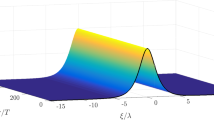Summary
This article shows in a statistical and numerical way that there is a relationship between moving cold fronts over the southern part of the North Sea and “gust bumps” — defined as pronounced sudden rises in the sea level — on the Dutch coast. The speed of the front is a crucial parameter in the occurrence of a gust bump, there being every indication that it must be between 29 and 36 kts. The conclusion can be drawn that resonance is present due to the coincidence of frontal speed and the speed of long waves in shallow waters. When the gust bump of 13 December 1956 was represented in a numerical model of the North Sea, there was a reasonable to good measure of agreement between the computed and observed deviations of the water level.
Zusammenfassung
Dieser Artikel zeigt statistisch und numerisch, daß ein Zusammenhang besteht zwischen Kaltfronten, die über den südlichen Teil der Nordsee ziehen, und Seebären an der holländischen Küste, die als ausgesprochen plötzliches Ansteigen der Meereshöhe beschrieben werden. Die Geschwindigkeit der Front ist ein entscheidender Parameter beim Auftreten eines Seebären, wobei alles darauf hinweist, daß sie zwischen 29 und 36 km liegen muß. Daraus kann geschlossen werden, daß infolge des Zusammenwirkens der Geschwindigkeit der Front und der Geschwindigkeit langer Wellen in flachen Gewässern eine Resonanz entsteht. Bei der Darstellung des Seebären vom 13. Dezember 1956 in einem numerischen Modell der Nordsee zeigte sich ein ziemlich gutes bis gutes Maß an Übereinstimmung zwischen den errechneten und den beobachteten Abweichungen des Wasserstandes.
Résumé
Le présent article montre statistiquement et numériquement qu'il existe une relation entre des fronts froids se déplaçant au-dessus de la partie Sud de la mee du Nord et les bourrasques — qui produisent d'importantes et brusques surélévations du niveau de la mer — sur la côte des Pays-Bas. En pareille occurrence, la vitesse du front est un paramètre crucial et tout semble indiquer qu'elle doit être comprise entre 29 et 36 noeuds. On peut en conclure qu'il y a là un effet de résonance dû à la coïncidence de la vitesse du front et celle des vagues longues en eau peu profonde. Lors de la reproduction par un modèle numérique de la bourrasque du 13 Décembre 1956 dans la mer du Nord, on a constaté, entre des limites raison nables et bonnes, une concordance des dénivellations calculées et observées.
Similar content being viewed by others
References
Bijvoet, H. C., 1957: A new overlay for the determination of the surface wind over sea from surface weather charts. Meded. en Verh. K. ned. met. Inst. No. 71.
Timmerman, H., 1965: Waterstanden langs de Nederlandse kust. Versl. K. ned. met. Inst. V-174.
Van der Houwen, P. J., 1966: On the stability of a difference scheme for the North Sea problem. Math. Centrum Amsterdam, TW 100.
Wemelsfelder, P. J., 1960: Bui-oscillaties en buistoten tijdens storminvloeden. Rapport Deltacommissie Deel4, 115.
Author information
Authors and Affiliations
Rights and permissions
About this article
Cite this article
Timmerman, H. On the connection between cold fronts and gust bumps. Deutsche Hydrographische Zeitschrift 24, 159–172 (1971). https://doi.org/10.1007/BF02226683
Received:
Published:
Issue Date:
DOI: https://doi.org/10.1007/BF02226683



